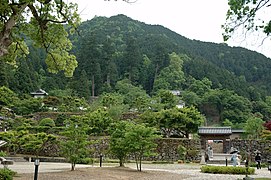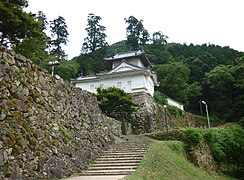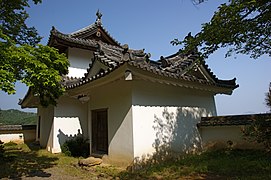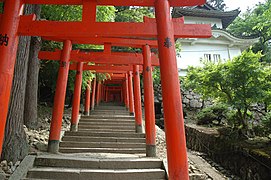Izushi Castle
| Izushi Castle | ||
|---|---|---|
|
Izushi Castle, Hommaru |
||
| Castle type : | Hirayamajiro (hill castle) | |
| Conservation status: | Partly reconstructed | |
| Place: | Toyooka | |
| Geographical location | 35 ° 27 '37.6 " N , 134 ° 52' 27.3" E | |
|
|
||
The Izushi Castle ( Japanese 出 石城 , Izushi-jō ) is located in the city of Toyooka in Hyōgo Prefecture . In the Edo period , the Sengoku last resided there as Fudai daimyo .
Lords of the castle in the Edo period
- From 1600 a branch of the Koide , which had resided there since 1595, was confirmed with an income of 60,000 Koku ,
- from 1697 a branch of the Fujii-Matsudaira with 48,000 Koku, and
- from 1706 to 1868 a branch of the Sengoku with 85,000 Koku.
history
Izushi Castle is located on the slope and foot of Mount Ariko (有 子 山), on which traces of an earlier castle can still be seen. The new castle was built in a modern form by the Toyotomi from 1580 . The present castle dates from 1604, when Koide Yoshihisa (小 出 吉英) was lord of the castle. The Koids were followed by the Fujii Matsudaira and then the Sengoku, who resided there until the Meiji Restoration in 1868. Among the Sengoku there was a dispute over the succession, which went down in local history as the Sengoku riots (仙 石 騒 動, Sengoku Sōdō). As a result, the clan's income was reduced by about half.
The attachment
For the castle at the foot of the Ariko Mountain, four levels were designed on the slope. From top to bottom are laid out: the Inari-kuruwa (稲 荷 曲 1; K1 in the plan) as a preliminary area, the Hommaru (本 丸; 1) the main area, including the second area (二 の 丸; 2) and a fourth area, the Yamasato-maru (山里 丸; 4) east. Two areas below protect the castle, the Shita-no-kuruwa (下 輪 曲 輪; K2) and the Nishi-no-kuruwa (西 の K 輪; K3) in the west. Above the Inari-kuruwa there is a small shrine (稲 荷 神社; red in the map), which is dedicated to the Inari .
Upstream in the plain is a castle complex with an east-west extension of almost 400 m, which is divided into two parts. The southern area is occupied by the third castle area, the San-no-maru (三 の 丸; 3), which extends in the north to the east-west street. This street leads to an east gate (東門, Higishi-mon; O) and a west gate (西門, Nishi-mon; W). To the north follows an area that included the chancellor's residence and dwellings for the higher samurai. A road leads through this area to the main gate (大 手 門, Ōte-mon; H) in the far north. These three gates are designed as "tiger mouth gates" (虎口 、 Koguchi), i. That is, their passage is angled and therefore not visible. Both areas are protected by earth walls (brown in plan) and ditches (blue), which are reinforced by walls around the gates. The trenches were lengthened on the mountain side by dry trenches.
Today most of the castle is designed as a park, with some of the walls preserved. In 1966 a watchtower was rebuilt on the east side of the Hommaru, in 1994 the front gate in front of the main gate with a bridge over the moat was restored.
photos
literature
- Kato, Masafumi: Izushi-jo. In: Miura, Masayuki (ed.): Shiro to jinya. Saikoku-hen. Gakken, 2006. ISBN 978-4-05-604379-2 . Page 55.
- Papinot, Edmond: Izushi In: Historical and Geographical Dictionary of Japan. Reprinted by Tuttle, 1972 edition of 1910 edition. ISBN 0-8048-0996-8 .









